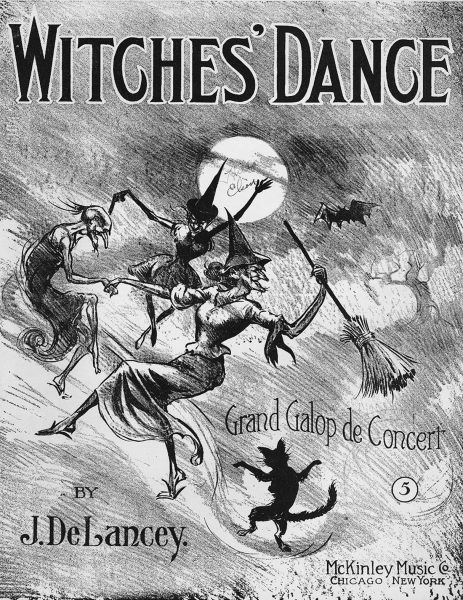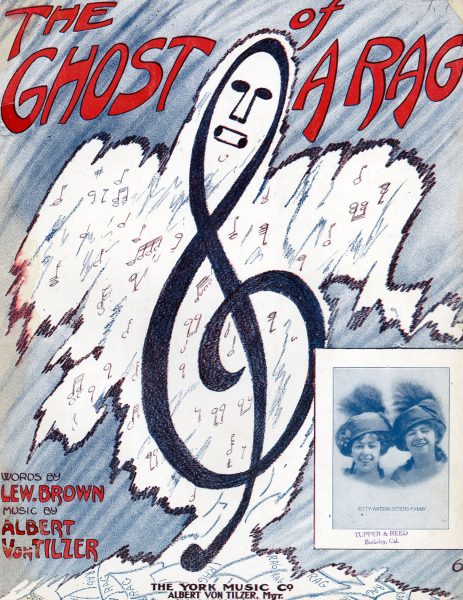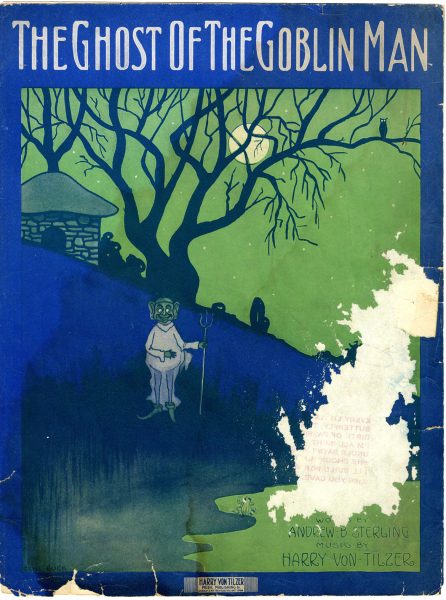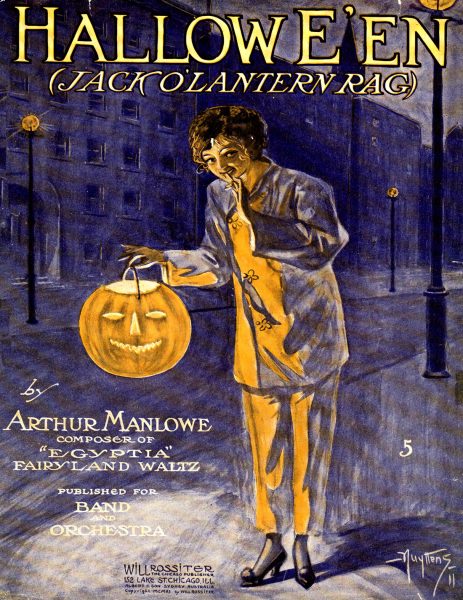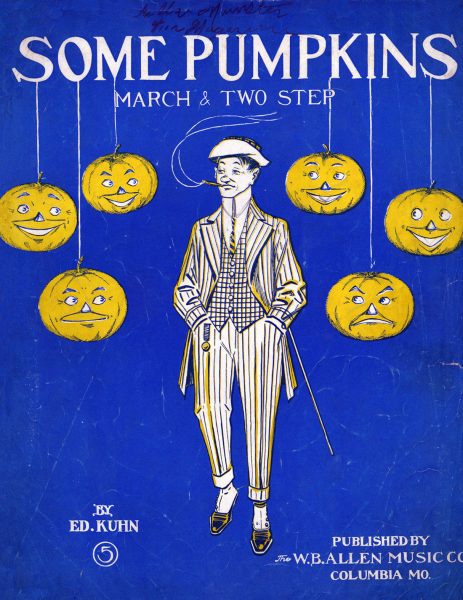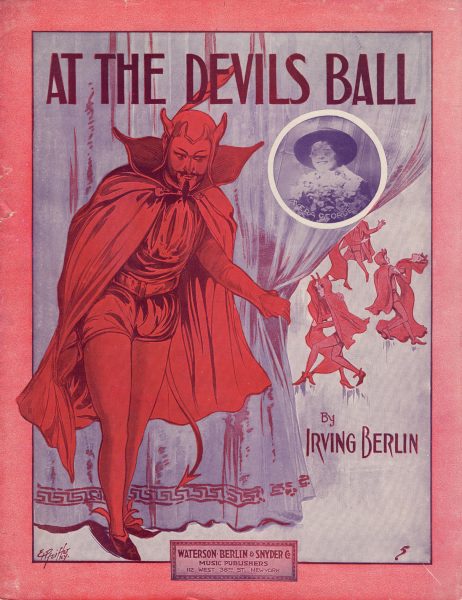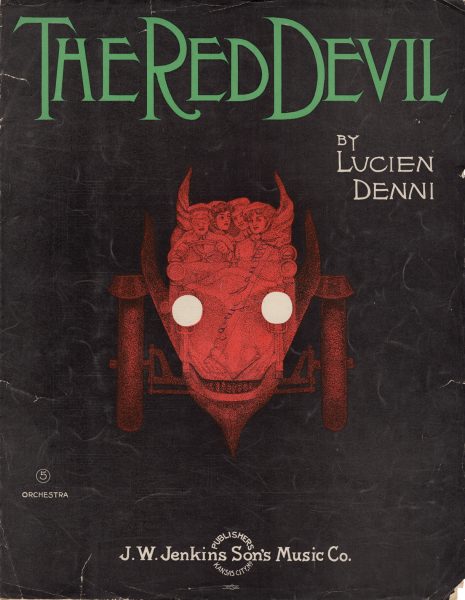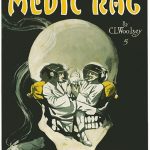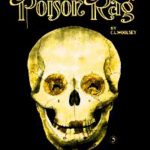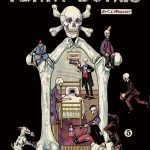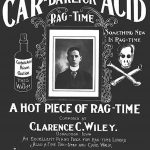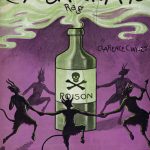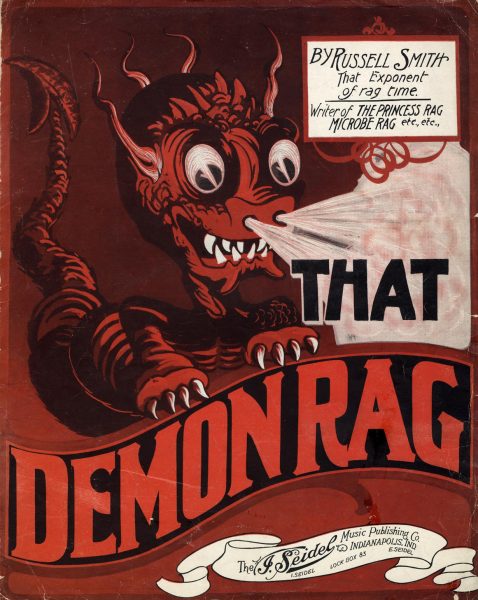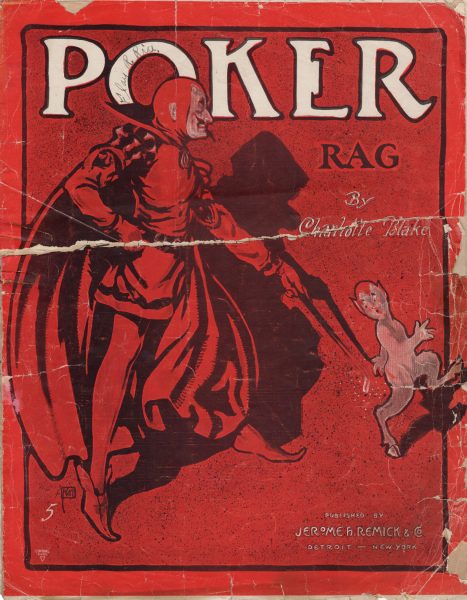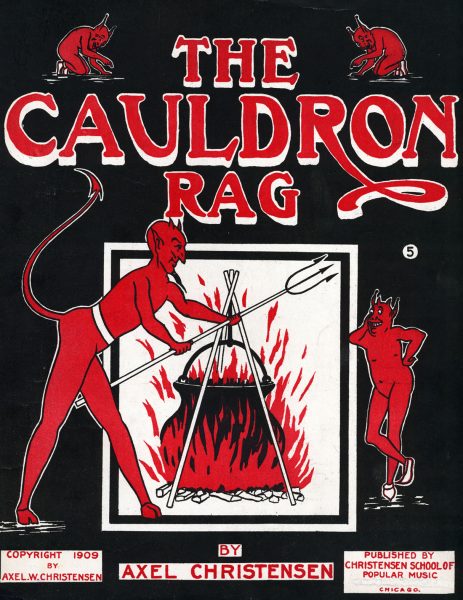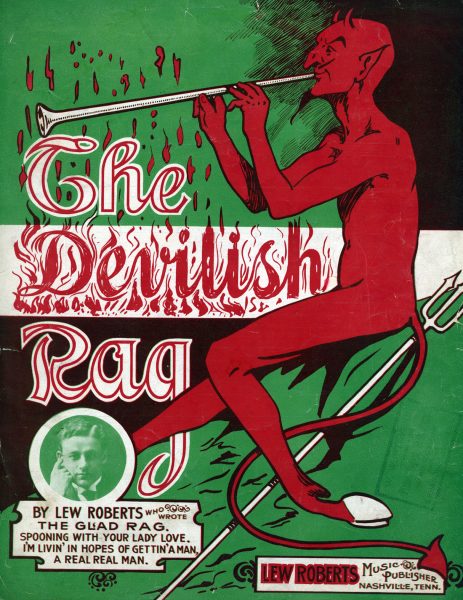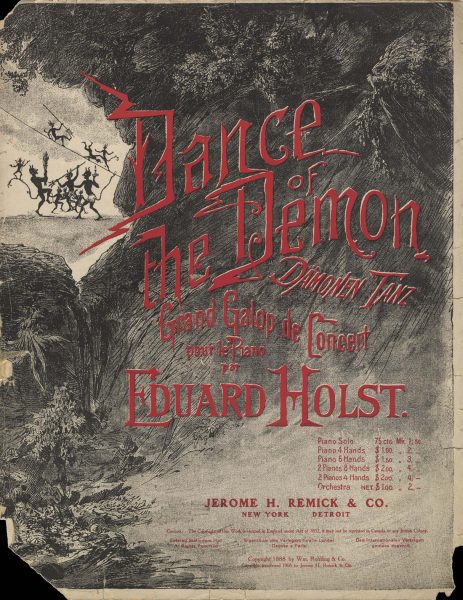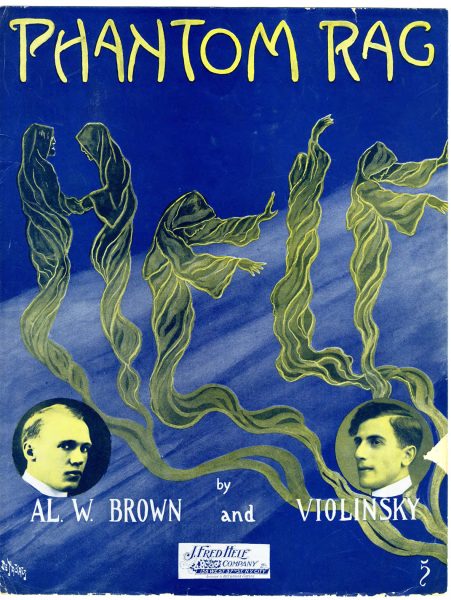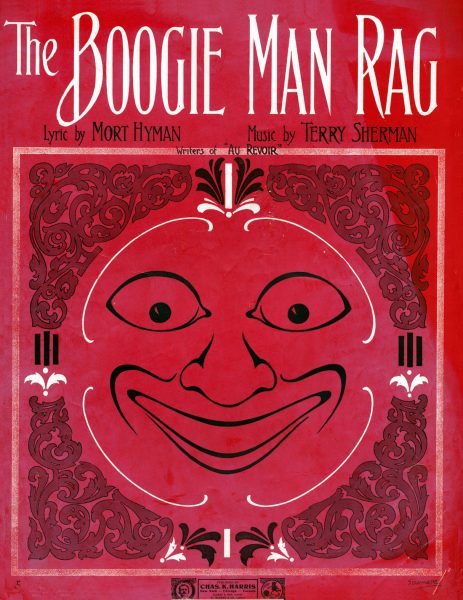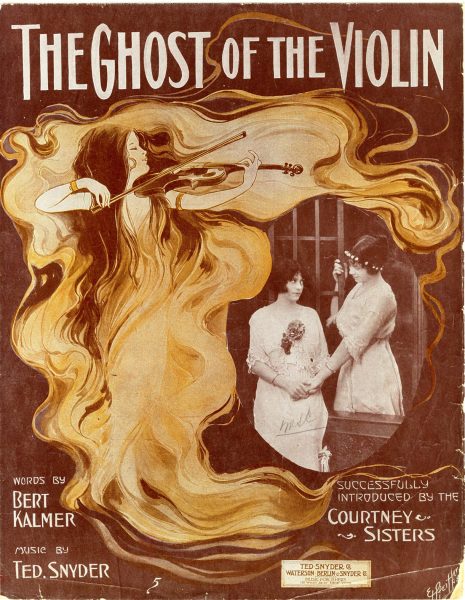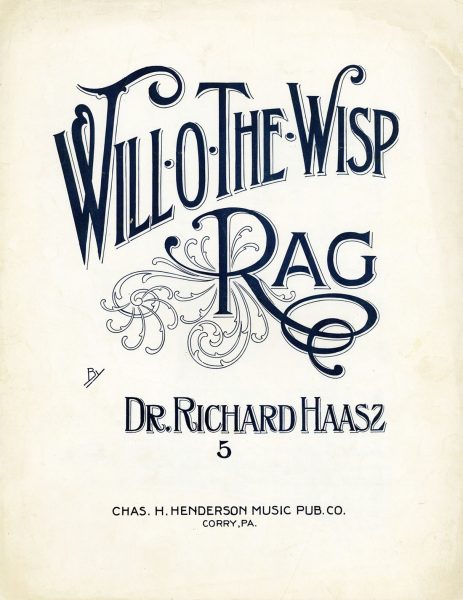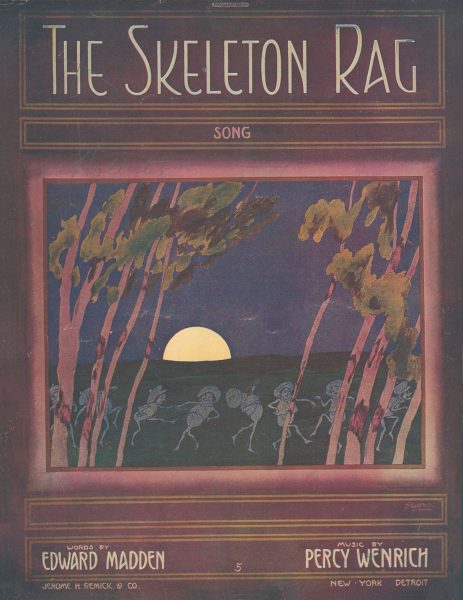Horror in Ragtime
With Halloween on the horizon, there is no better time to reminisce about the days of old. While ragtime is generally known for its bright and cheerful tunes, it too had a darker side. The golden age of ragtime saw a revolution in the design of sheet music title pages (or covers as we know them). Now publishers often relied on eye-catching and flashy covers to sell music. Covers with intense illustrations of every kind filled store shelves, much like the record stores of today. Almost no subject was left untouched, especially not Halloween or other morbid curiosities.
As the majority of ragtime music was published in the United States, it is important to understand the context of the Halloween at the time this music was being published. Halloween had been celebrated in North America for some time; however it didn’t become a popular American practice until around the turn of the twentieth century. Ragtime, as the popular music of the day, of course, kept up with trends and popular culture. The first record of people dressing up in costume in the United States was in 1911. Arthur Manlowe’s Hallowe’en (The Jack O’ Lantern Rag) is copyrighted 1911 and appears to show a girl in costume along with a jack-o’-lantern in her hand. This may suggest the practice of “guising” was already somewhat popular by 1911. The depiction of jack-o’-lanterns is not unusual as this tradition had been in practice for many decades and is also depicted on Ed Kuhn’s 1908 rag Some Pumpkins. Halloween’s more than a couple carved pumpkins though.
Many traditions, stories, and motifs surround the idea of demons and devils. Even in a society considered conservative by today’s standards, images of the devil and his minions found their way onto store shelves and music stands across the country. Many are rather innocent such as Irving Berlin’s 1913 song At the Devil’s Ball. Others bear a more sinister look to them such as The Red Devil by Lucien Denni or The Lincoln Imp by Joseph Clauder which includes the story of the imp on the inside cover. Pitchforks and pumpkins, of course, weren’t all people were dancing to back then.
It seems man has always had a sort of morbid curiosity. There was a time when dead outlaws would have their corpses displayed in coffins for the public to see and séances were still a subject of curiosity. With such a fascination with death, it’s no surprise that images of skeletons soon found their way into music stores too. Oftentimes the title and illustration of a piece had nothing to do with the music. Calvin Lee Woolsey’s rags Medic Rag and Poison Rag bear remarkably similar skull cover art despite the differences in their titles. Indeed, Clarence C. Wiley’s hit Car-Barlick-Acid is another bright ragtime tune with death-themed art work. Between skeletons, demons, and acid, the creativity behind the artwork is apparent.
As interesting or impressive as these covers are, they are only a tiny fraction of the musical history available to discover and enjoy. The turn of the century was a wild time, full of new ideas, pushing the limits of popular taste and public tradition. If you enjoyed this artwork, why not take a quick trip to our cover gallery containing hundreds of unique original covers? Or, if you need some more vintage inspiration, follow us on Instagram for quick bites of music history and artwork. Either way, have a happy Halloween!
BOO!
If you’re interested in playing any of the music mentioned in this article, the piano scores to most of them have been posted below. The sources of the covers shown that were not part of our collection have also been listed below.
Hallowe’en (The Jack O’ Lantern Rag), Arthur Manlowe, 1911, http://digital.library.msstate.edu/cdm/singleitem/collection/SheetMusic/id/26235/rec/1
Some Pumpkins, Ed Kuhn, 1908, http://digital.library.msstate.edu/cdm/singleitem/collection/SheetMusic/id/26378/rec/1
The Cauldron Rag, Axel Christensen, 1909, http://digital.library.msstate.edu/cdm/singleitem/collection/SheetMusic/id/25110/rec/5
The Red Devil, Lucien Denni, 1910, http://digital.library.msstate.edu/cdm/singleitem/collection/SheetMusic/id/25069/rec/6
Oh! You Devil, Ford Dabney, 1909, http://digital.library.msstate.edu/cdm/singleitem/collection/SheetMusic/id/24962/rec/4
The Devilish Rag, Lew Roberts, 1908, http://digital.library.msstate.edu/cdm/singleitem/collection/SheetMusic/id/26433/rec/12
Poker Rag, Charlotte Blake, 1909, http://digital.library.msstate.edu/cdm/singleitem/collection/SheetMusic/id/24205/rec/15
The Lincoln Imp, Joseph Clauder, 1903, http://digital.library.msstate.edu/cdm/singleitem/collection/SheetMusic/id/35005/rec/16
That Demon Rag, Rusell Smith 1912, http://digital.library.msstate.edu/cdm/singleitem/collection/SheetMusic/id/24279/rec/5
The Black Cat Rag, Frank Wooster & Ethel B. Smith, 1905, http://digital.library.msstate.edu/cdm/singleitem/collection/SheetMusic/id/24267/rec/1
Will O’ The Wisp Rag, Dr. Richard Haasz, 1911, http://digital.library.msstate.edu/cdm/singleitem/collection/SheetMusic/id/25641/rec/297
Witches’ Dance, J. DeLancey, 1909, http://digital.library.msstate.edu/cdm/singleitem/collection/SheetMusic/id/24883/rec/12
Dance of the Demon, Eduard Holst, 1906, http://digital.library.msstate.edu/cdm/singleitem/collection/SheetMusic/id/4182/rec/13
At the Devil’s Ball, Irving Berlin, 1913, http://digital.library.msstate.edu/cdm/singleitem/collection/SheetMusic/id/23804/rec/3
That Devilish Glide Rag, R. G. Grady, 1912, http://digital.library.msstate.edu/cdm/singleitem/collection/SheetMusic/id/25638/rec/173
The Skeleton Rag Song, Percy Wenrich, 1911, http://digital.library.msstate.edu/cdm/singleitem/collection/SheetMusic/id/27059/rec/9
The Soul Kiss (Just for You from Above), Lewis Gates and Maurice Levi, 1908, http://digital.library.msstate.edu/cdm/singleitem/collection/SheetMusic/id/6399/rec/28
The Boogie Man Rag, Mort Hyman and Terry Sherman, 1912, http://digital.library.msstate.edu/cdm/singleitem/collection/SheetMusic/id/27063/rec/331
The Mad House Rag, Edgar Leslie and Freddy Watson, 1911, http://digital.library.msstate.edu/cdm/singleitem/collection/SheetMusic/id/27065/rec/405
The Ghost of a Rag, Lew Brown and Albert Von Tilzer, 1912, http://digital.library.msstate.edu/cdm/singleitem/collection/SheetMusic/id/27094/rec/424
The Ghost of the Violin, Bert Kalmar and Ted Snyder, 1912, http://digital.library.msstate.edu/cdm/singleitem/collection/SheetMusic/id/34953/rec/3
The Ghost of the Goblin Man, Andrew B. Sterling and Harry Von Tilzer, 1912, http://digital.library.msstate.edu/cdm/singleitem/collection/SheetMusic/id/34952/rec/5
That Mysterious Rag, Irving Berlin, 1911, http://digital.library.msstate.edu/cdm/singleitem/collection/SheetMusic/id/96/rec/2
Car-Barlick Acid, Clarence C. Wiley, 1903, http://www.perfessorbill.com/covers/carbrlk.jpg
Car-Barlick Acid, Clarence C. Wiley, 1904, http://sheetmusic.library.sc.edu/MusicPrint.asp?mid=3294
Car-Barlick Acid, Clarence C. Wiley, 1907, http://digital.library.msstate.edu/cdm/singleitem/collection/SheetMusic/id/27081/rec/2
Funny Bones, Calvin Lee Woolsey, 1909, http://digital.library.msstate.edu/cdm/singleitem/collection/SheetMusic/id/23822/rec/1
Phantom Rag, Al. W. Brown & Violinsky, 1911, http://digital.library.msstate.edu/cdm/singleitem/collection/SheetMusic/id/36837/rec/21
Medic Rag, Calvin Lee Woolsey, 1910, http://www.ragpiano.com/comps/cwoolsey.shtml
Poison Rag, Calvin Lee Woolsey, 1910, https://www.ragtimeguitare.com/3.html
Information regarding early Halloween traditions and history were learned from: https://en.wikipedia.org/wiki/Halloween



